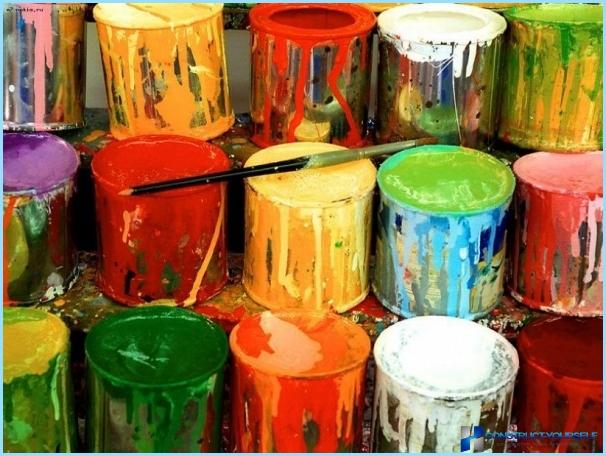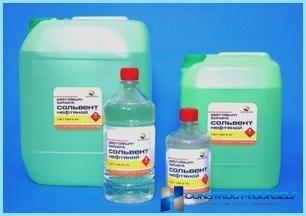The contents
- What is the Solvent?
- Why the need for a Solvent?
- How to apply the solvent
- Safety
- Characteristics of the solvents
What is the Solvent? ↑
The solvent is a solvent that is produced by evaporating petroleum. Today it is produced in two forms:
- «oil», GOST 10214-78;
- «coal» GOST 1928-79.
This class of solvents falls under a number of volatile materials.
The main feature of the Solvents is a high degree of dissolution of a variety of paints. Additionally, it can be noted that the solvents after application to the treatment area, have the ability very quickly «to evaporate», also taking together with him all the smells.

What Solvent? ↑
Solvent for paints Solvent, both oil and stone (Nefras And 130/150) widely used in construction and automotive work when there is a problem with the breeding of alkyds, enamels and other materials before they «working» state. The most common substances for which use solvent, are epoxyethers, with a, kremniyorganika, phenols, polyacrylate, melaminoalkidnye, alkide-urethanes, alkido-sterols and some less common materials.
How to apply solvent ↑
In the construction industry solvent used to create the desired viscosity of paint materials. For its proper application, it is necessary to slowly add solvent to the material and thoroughly stir until a soft consistency. Sometimes the oil solvent used for degreasing. For this, all you need is just to wet some cloth with petroleum solvent and wipe the treatment area.
Safety ↑
As any solvent liquid, the Solvent is a flammable liquid and has a very specific smell. The main rule in the beginning with the liquid, is the presence of a protective suit, mask, respirator and gloves. The thing is, what if it randomly gets on your skin (not to mention the eyes), it can at best be irritating, and with abundant ingestion – burns.
If it so happened that the Solvent accidentally hit you on the skin should immediately be washed in warm soapy water. With regard to the possible ignition of the fluid, if it happened to extinguish it should be exclusively by means of fire foam, sand or carbon dioxide, in any case do not use water to extinguish.
Characteristics of solvents ↑
The Solvent Of Coal ↑
- Application: this solvent is designed for use in cases where it is necessary to dissolve or dilute these coating materials, as varnishes, paints, enamels, rinsing and washing fluid in the automotive industry etc.
- Composition: aromatic hydrocarbons, which get into the course of treatment is fractional of crude benzene and pyrolysis resin.
- Color palette: there is only laborantom color or fully transparent.
- Sign quality: density at 20 degrees Celsius, kilogram per cubic meter should not be less than 864; «volatilization» the xylene should not be more than 1.2; the mass of sulfur, in percent, does not exceed — 0,005; the mass of phenols, in percentage, less — 0,0022; reaction of aqueous extract neutral; the minimum required temperature for the boil — 125 degrees Celsius.
- Packaging: barrel volume 220л (185 pounds).
- Manufacturers of: domestic and foreign.
- Recommended shelf life: 1 year from production date.
Solvent Oil ↑

- Application area: this chemical material is used in cases when you want to dissolve substances based on oil, bitumen, rubber, resin, oil resin, polyetherimide and polyetherimide. Additionally and for melaminoalkidnye of ecomaterials and printing.
- Composition: aromaplastie with low fractions of naphthene, paraffin cyclic hydrocarbon.
- Color palette: there is only the fully transparent state.
- Sign quality: density at 20 degrees Celsius, grams per cubic meter should not be less than 0,861; the volatile xylene, must not exceed 1,21; mass part of sulfur, in percent, must not exceed 0,021; the mass of sulfuramid materials, in percent, shall not be less than — 98,9; reaction of aqueous extract neutral; the minimum required temperature for the boiling point — 150 degrees Celsius.
- Packing: cartons for 9 liters (8 kg), and cans of 218 liters (172 kg).
- Manufacturers of: domestic and foreign.
- Recommended shelf life: 1 year from date of production.
Choose a solvent or white spirit ↑
Let’s first look at what the phrase means «White spirit»? For anybody not a secret that in a literal translation from the English we get the phrase «white spirit» (where the spirit means the spirit, and white — white, transparent)
If you connect the imagination, we can come to some strange spiritual transformations. But everything is much more banal.
“White spirit” and “Solvent” – both chemical, get during the distillation of crude oil. Under high temperature conditions, the oil overheats and forms a pair of a variety of hydrocarbons. The resulting pairs are divided into classes that vary with its temperature limit of boiling. It is because of different boiling point and obtained a variety of chemical reagents.

As for the boiling point – it means that at a certain temperature, the particles of the evaporation of oil starts to convert in the solvent. Actually this lies the fundamental difference White-spirit Solvent, because. «spirit» begins to form at less high temperatures than the second class of solvents.
For clarity, we give an example for such individual substances, such as water. It will boil at a temperature of from 100 degrees Celsius – the point is that only under this condition it will begin to evaporate. But the difference of solvent-and water is that water is a homogeneous substance, and the solvent is a kind of mixture of different components. Hence logically it turns out that all their components will also have different boiling points, respectively, and causes to form two different solvent separately from each other.
To conclude, we can say that the Solvent, as a mixture of more simple components, is beginning to shift from a liquid to a gas at relatively low temperatures, and therefore dries faster. It is this quality of the solvent gives him the advantage over quick-drying paints, and due to low content of oily substances (which is preserved in the process of formation of the solvent), makes the surface glossy.
Now, with respect to «White-spirit». The time of drying is longer, because its boiling point is 200 degrees Celsius. In the course of obtaining it retained greater amounts of the oil components than the Solvent. This quality makes it unique when creating on the treated surface matte shade. We can say that the solvent white spirit is more rational to apply only to surfaces of metal, where it is necessary to carefully clean the surface.
For comparison, place a large sheet of paper a drop of the two solvents, and You will certainly see that it is better. But then it all comes down not to the fact «who is cooler», and besides, for what purpose you need the solvent. If you need a quick drying capacity, along with a glossy sheen, the Solvent is the right choice, but if you want to create an extra layer of protection and Shine to the surface, the use «White spirit» here is undeniable. The main thing is to determine the purpose for which You need the solvent.






